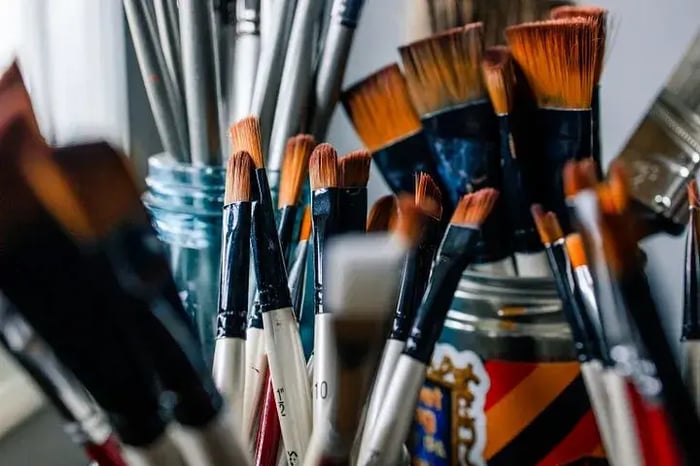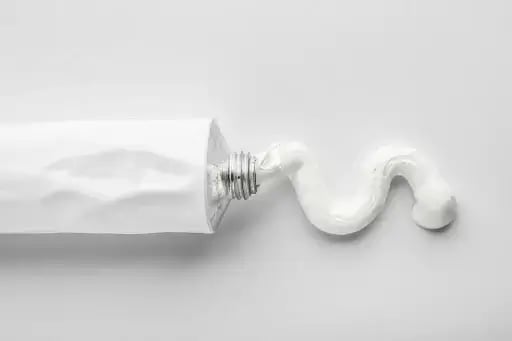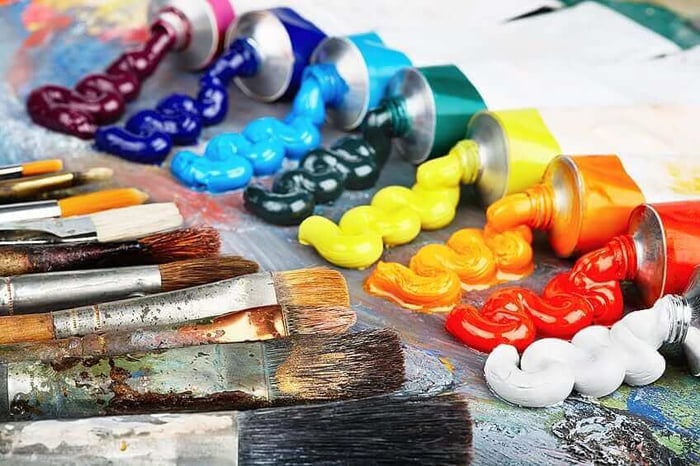Many oil painters would consider solvents as an essential element of their toolkit, but what is it? How is it used? If you have questions about the safety of solvents, solvent alternatives, or simply which solvent to choose - the Art to Art team is here to answer them!
Overview
- Why do we use solvent?
- What is solvent?
- What is solvent made from?
- Is solvent dangerous and unhealthy?
- How do I use solvent in my practise safely?
- How do I store solvent?
- Should I use solvent or a soup brush cleaner?
- How do I dispose of old solvent?
- FAQ
Why do we use solvent?
The most common reason we use Solvent when painting in oils, is to clean our brushes. When our brushes are covered in oil paint, the best way to remove the paint is to rinse our brush in a jar of solvent and then dab or wipe it dry on a rag or paper towel. Solvent is also be used in the initial underpainting process to create a thin layer or a wash of paint for ‘blocking in’, or as the ‘ground’ to tone a canvas. The addition of solvent for this first layer greatly reduces the drying time of oil paint, however it is not recommended to keep using solvent in subsequent layers as the paint is hindered in its ability to form a stable paint film, so it doesn’t lend greatly to the health and longevity of the artwork.
What is solvent?
Solvent can be a very broad term – essentially it is any liquid capable of thinning or dissolving a substance. Water, for example is technically a solvent, because water can dissolve and break down certain materials. The four main solvents are Water, Ethanol, Methanol and Acetone.
The solvents used for oil painting are Mineral Turpentine and White Spirit. These are both incredibly strong solvents suited for thinning and dissolving oil paint and varnishes. Please note: these can be both odorous and toxic, so we recommend opting for low toxic and odourless versions such as Solvent 75.
What is solvent made from?
Mineral Turpentine can be made several ways, to create common Solvents used in oil painting methods such as Pure Gum Turpentine, Wood Turpentine and White Spirits.
Traditionally distilled from the sap of pine trees Pure Gum Turpentine; the harshest of mineral solvents is commonly used in dissolving oil paint and stripping off varnish when required. It can also strip your oil paint resulting in a less than desirable powdery, weak film. This isn’t great for the longevity of your painting or your brushes as they become dry and brittle, prone to breakage and cracking.
The most found turpentine, Wood Turpentine is made from steam-distillation of wood chips. Wood Turpentine is a little more suited for oil painting as it is less harsh than Pure Gum Turpentine.
Artists Mineral Spirit is a petroleum derived turpentine substitute, resulting in a gentler and safer option for artists in the studio. Mineral Spirits is commonly used for cleaning brushes, varnished paintings and is considered a better solvent for use in oil painting methods due to its milder properties allowing the paint to maintain some strength in its film and bind to the surface.

Is solvent dangerous and unhealthy?
Solvent is considered dangerous and unhealthy; it gives oil painting the perception of being unsafe and bad for the environment. However, oil paint can be perfectly safe for you, with the right knowledge and precautions.
Mineral Turpentine is very flammable and has the protentional with over-exposure to irritate your skin and eyes and damage your respiratory system. Ingestion being the worst, with abdominal pain, nausea, confusion, vomiting and chemical pneumonia. It is also common for artists who have practiced with solvent for a long time to develop allergies or illnesses from improper Turpentine use, leaving them unable to use them permanently. When painting with a Mineral Turpentine like Pure Gum Turpentine it is recommended that you practice great caution.
Artists have found the negative qualities of Turpentine dislikable over the centuries and have strived to create newer and safer formulas. They achieved this with the Artists White Spirit, being a petroleum distillate it’s much safer than Mineral Turpentine and is a favourite among artists. Contemporary White Spirits have evolved further as well, with favourites being Langridge’s Solvent 75 and Gamblin’s Gamsol, these two White Spirits being very low odour and toxicity and much safer for the artists health. They also have a flash point of 71 degrees, and are therefore not considered flammable goods, so can be shipped worldwide, they are the best option for any artist wanting to use solvents in their practice and are concerned about their health.
How do I use solvent in my practise safely?
Ventilation is key to safely practicing with solvents. This will help you avoid any sickness, illness, or nausea from overexposure to solvents. If you are painting indoors you’ll want to make sure that you have several windows open close by, if you are fortunate you can have an extraction fan running. Most people don’t have the space in their home to safely practice oil painting with solvents, so they opt to paint in their shed, garage, or car port which is considered ideal because these spaces are very well ventilated.
It’s important to keep solvent sealed when not in use, so keep it stored in a container with a lid. Try to keep it away from any open flames, so keep your painting practice out of your kitchen if possible.
If you don’t have the option of painting in a garage or shed and inside is your only option, we highly recommend using the Solvent 75 and Gamsol as your solvent of choice because it greatly reduces the fumes and health concerns, however it’s still wise to practice caution even with these low toxicity solvents.
How do I store solvent?
Solvent should be stored in a container or jar with a closed lid and out of reach of children and away from any place where it could fall and spill. It should be kept away from any open flames and should be kept out of direct sunlight because it will evaporate.
Should I use a solvent or a soap brush cleaner?
You can use one or the other, however most artists do use both in the same practice. They do this by cleaning their brushes during the painting process with solvent, then at the end clean them thoroughly with a soap-based brush cleaner. A brush cleaner will greatly increase the longevity of your brushes. A lot of artists have completely traded in their solvents for a soap-based brush cleaner. This is a fascinating practice and is worth a study if you’d prefer to be completely rid of nasty solvents. Artists who practice without solvent will simply pinch and brush out excess paint from their brush into a rag during the painting process and at the end of a painting session clean with a brush cleaner and water.
The biggest drawbacks to a completely solvent-free approach to oil painting is that it limits your choice of mediums considerably, mainly leaving you with Linseed oil and Safflower oil, of which both greatly elongate the drying time of your oils. There are alternatives for instance, like Langridge’s Oleogel and Gamblin’s Solvent Free Painting Gel, yet these two still don’t improve the drying time of oils, each being 24-48 hours till touch dry. Without a fast-drying medium to use a lot of artists use oil paint without a medium, which does still dry faster than using linseed or safflower oil, however it is very challenging to move the paint on the canvas because of oils thick buttery consistency.

How do I dispose of old Solvent?
The simplest way to dispose of Solvent is to take it to your local hazardous waste facility. These facilities will take your solvent and dispose of it in a safe manner. However, most artists have never done this as solvent does evaporate naturally. I know for myself; I have never disposed of a single drop of solvent because it naturally reduces over time. Solvent does become dirty after a lot of use and that can leave your brushes still dirty even after giving them a rinse, the way clean that solvent is to simply put it aside and let the paint particles in the solvent to settle on the bottom on the jar, they will harden and dry if you leave them long enough, then you pour the new clear solvent on the top into a new jar.
FAQ
My class told me to get an odourless solvent which one should I get?
A lot of people go to the department store to grab a cheap brand of odourless solvent thinking that it is the healthy alternative to the full strength one. It’s important to impress onto you that usually odourless solvent, especially products marketed as simply “Odourless Solvent” or “Odourless Thinner” are no less toxic than a full-strength Mineral Turpentine. This product simply has had its odour removed, this is great if you find the smell dizzying, yet it fails to communicate if your painting space is well ventilated or safe. One of the things our sense of smell does is alert us to protentional dangerous hazards, and when dealing with a very toxic substance getting rid of its smell does absolutely nothing to negate its hazard, it simply removes our ability to discern its hazard. So, instead of buying an Odourless Thinner, please explore other options like Langridge’s Solvent 75 and Gamblin’s Gamsol, which are just as odourless and the same cost if not cheaper than an “Odourless Thinner”, but also if you want a stronger solvent than those two you can go with Langridge’s Low Toxic Solvent.
What are the best solvents on the market now?
The best solvents on the market right now are hands down Langridge’s Solvent 75 and Gamblin’s Gamsol. These two products are the lowest toxicity, lowest flashpoint, lowest odour solvents on the market and are incredibly safe for the artists health.
I spilled solvent on my hands what should I do?
Wash your hands, and don’t let it happen again. You will notice that your hands may feel very dry afterwards, even after washing them, that’s okay that will go away in a few hours. It’s not the end of the world but it is not ideal, as skin contact, especially with very strong solvents like Turpentine, is quite bad and prolonged skin contact can result in illness. If you feel like in your practice solvent contacting your skin will happen often, please consider wearing gloves.
Can I paint with only solvent and no medium?
I don’t see why not, there’s nothing intrinsically wrong with doing that at all. Some artists love the watercolour-like effect that you can get from doing a whole painting in just solvent. I know I used to really enjoy letting the solvent leave a dripping mark on the canvas and leaving big “Turpentine Burns” throughout a painting. So, if that’s what you would like to do in your practice that’s completely fine. Do keep in mind that the archival quality of your work will be diminished, by only using solvent you are stripping the paint of its oil, which isn’t great because it needs the oil for the pigment to adhere and dry. I would advise you if you do wish to paint with only solvent to consider varnishing your works. The drying time is greatly reduced with solvent, so you won’t have to wait the full year before application, but you will still need to wait several months. Consider trying Gamblin’s Gamvar varnish, which can be put on an oil painting once touch dry.
Can I use methylated spirits instead of white spirit or turpentine?
The short answer is no, you will experience a lot of difficulties trying to clean your brush and paint with Methylated Spirits as it is simply too weak. It’s normal for a beginner to experience confusion between all these different solvents and mistake Methylated Spirits as an adequate solvent for cleaning away oil paint. However Methylated Spirits is an Ethanol based solvent meaning its derived from the distillation of sugars in barley, grain, corn, and other such organic materials. This makes the Methylated Spirits considerably weaker as a solvent compared to White Spirits and even weaker next to Mineral Turpentine, which are a methanol solvent, considered a much stronger solvent.
Your one-stop shop for art supplies
And there you have it, your guide to solvents! At Art to Art, we have a wide selection of art supplies to choose from, including oil paints, varnish brushes, colour pencil sets and so much more! Upgrade your collection today and experience the quality! Same day, Dispatch Australia-wide. Before you go, don’t forget to check out our collection of markers, paint pens and drawing accessories.







